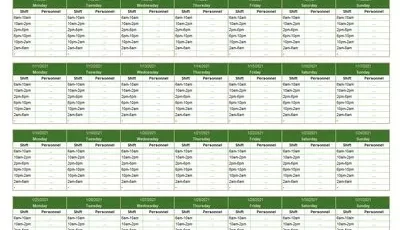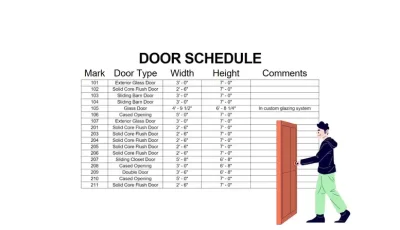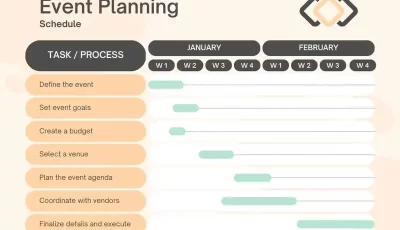Hey there! Let’s talk about an 8-hour shift schedule for 7 days a week. It’s a cool way for businesses to keep running all day, all night, every day of the week. Imagine a store that needs to stay open 24/7. That’s 24 hours a day, 7 days a week!
What It Is

8-Hour Shift Schedule For 7 Days A Week – A 24 7 open store with lights on at night, symbolizing continuous operation
This schedule is like a team relay! Workers take turns doing their jobs in shifts so that the business can stay open. Each shift is 8 hours long. So, in one day, three different teams can work – morning, afternoon, and night. This way, there’s always someone to keep things running smoothly.
Work Hours Limit
Here’s something important: we must ensure no one works too much. We keep the work hours to 40 hours a week for each person. This is like saying you can’t work more than five 8-hour weekly shifts. It’s a rule to ensure everyone gets enough rest and is energized.
Scheduling Variants
There are different kinds of 8-hour shifts. Let’s look at them:
- Day Shifts: This is like a normal workday, starting in the morning and ending in the afternoon.
- Swing Shifts: These shifts start in the afternoon and end at night. It’s like taking over from the day shift people.
- Night Shifts: This one starts at night and ends in the morning. It’s for when the day shift and swing shift people are done and are resting at home.
So, that’s the 8-hour rotating shift schedule! It’s a great way for businesses to keep going all the time and for workers to have a good balance between work and rest.
Pros of the 8-Hour 7-Day Work Schedule
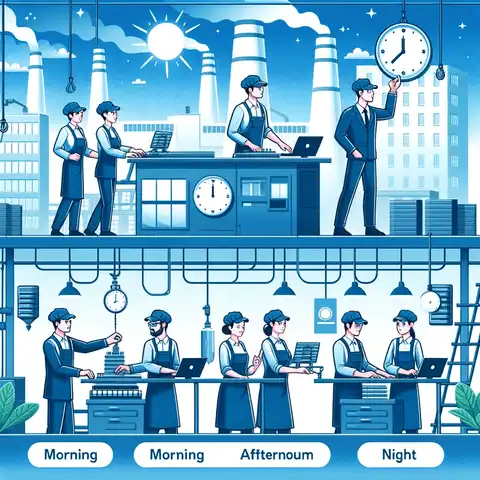
8-Hour Shift Schedule For 7 Days A Week – Employees working in shifts at a factory, showing a team relay of morning, afternoon, and night shifts
Hey friends! Today, let’s chat about the cool things about working an 8-hour shift 7 days a week. It’s not only good for the people who work but also for the businesses. Let’s break it down:
Advantages for Employees

8-Hour Shift Schedule For 7 Days A Week – A group of happy employees enjoying a break, representing fair workload distribution and time to relax
- Fair Workload Distribution: This schedule is like sharing a big cake fairly at a party. Everyone gets an equal slice, right? Similarly, in this work schedule, everyone gets equal work. This means no one is tired because they worked too much, and everyone gets enough days off to relax.
- Rotating Shifts for Work-Life Balance: Imagine a seesaw. On one side is work, and on the other is home life. The rotating shifts help keep this seesaw balanced. Employees know when they’ll be working and when they can enjoy time with family, hobbies, or just relaxing. It’s like having a routine that also helps you plan your fun times!
Advantages for Employers
- 24-Hour Business Operation: This is like having a team that keeps the lights on constantly. Businesses can keep running day and night without stopping. It’s great for places like hospitals or stores that always need to be open.
- Cost Savings and Reduced Burnout: Changing shifts less often means saving money. Fewer changes also mean workers are happier and less tired. Imagine if you had to change what you’re doing every hour. You’d get tired. Less change means employees are more alert and make fewer mistakes.
So, this 8-hour, 7-day work schedule is a win-win for everyone! Employees get a fair amount of work and time to enjoy life, and businesses can keep going around the clock without making anyone too tired.
Cons of the 8-Hour 7-Day Work Schedule
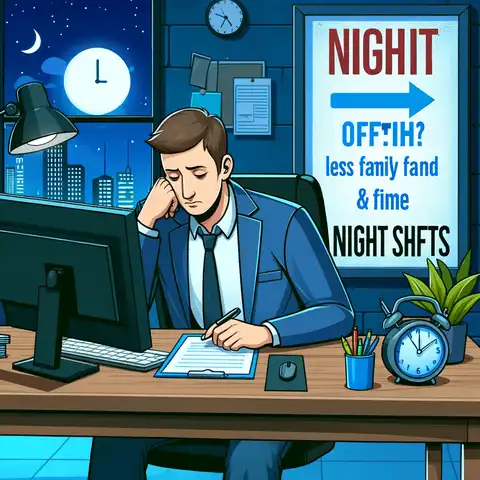
8-Hour Shift Schedule For 7 Days A Week – A tired employee sitting at a desk at night, depicting the challenge of less family and fun time due to night shifts
While the 8-hour, 7-day work schedule has many pros, it’s also important to look at the other side – the cons. Just like most things, this work schedule isn’t perfect for everyone. Let’s dive into some of the downsides:
- Less Family and Fun Time: Imagine you have a soccer game or a birthday party to attend, but you must work instead. This can happen with rotating shifts, making it hard to join family dinners, hang out with friends, or be there for special moments.
- Feeling Tired and Out of Sync: Our bodies have a natural clock, like an alarm clock inside us, telling us when to sleep or wake up. When people work at different times, like night shifts, their body clocks can get mixed up. This might make them feel sleepy at work or wide awake when they should be sleeping.
- Hard to Always Do Your Best: Think about playing a game where the rules keep changing. It can be confusing. If workers’ schedules change a lot, it might be hard always to do a great job. They might feel more sure about their work or need help to keep up.
- Tricky for the Bosses: For the people managing the workers, it’s like trying to solve a tough puzzle. They have to ensure everyone knows when to work and is trained well. This can be a lot of work, especially if many people are on the team.
- Feeling Really Worn Out: Even though the schedule is fair, sometimes workers can still feel super tired or stressed. This is especially true if they have many days of work in a row or if they have to work a lot of night shifts.
How to keep track of an 8-hour, 7-day work schedule?

8-Hour Shift Schedule For 7 Days A Week – A person using the app on their phone, highlighting the convenience of managing work schedules
This is where it comes in as a handy solution. Let’s break down how we can help:
- Cloud-Based System: It is a cloud-based system. You don’t need any special machines or hardware to use it. It’s all online, like storing photos or documents in the cloud and accessing them from any computer or phone.
- Easy Deployment: Since software, you can easily set it up anywhere. It’s like downloading an app on your phone – simple and quick.
- Using AI for Attendance: AI, which stands for Artificial Intelligence, is used to recognize people’s faces. It’s like how your phone can unlock by looking at your face. When employees come to work, they show their face to the system, and it knows they are there and records the time.
- Convenient for Workers: Your employees can download the app on their phones. This means they can check their work schedule, mark their attendance, ask for leave, and do other things from their phone. It’s like having their work schedule and attendance system in their pocket.
- Alerts and Reports: it also has features for alerts and reports. This means it can send notifications about shifts or any changes. It also creates reports to see who worked when and how many hours they worked.
How to Create an 8-Hour Shift Schedule for 7 Days a Week
Let’s learn how to make an 8-hour shift schedule that works every day of the week. Let’s get started:
- Decide on Shift Times: First, consider when the shifts start and end. Since each shift is 8 hours, you can have shifts like:
- Morning Shift: This could start at 7 AM and end at 3 PM.
- Afternoon Shift: This one starts at 3 PM and ends at 11 PM.
- Night Shift: This one could start at 11 PM and go until 7 AM the next day.
- Set a Weekly Limit: Ensure no one works more than 40 hours weekly. This is like a rule to keep everyone from getting too tired. Everyone needs to have enough rest.
- Make a Team Plan: You’ll need enough people to cover all the shifts. Plan out how many teams you need and who will be in each team. Team A could work in the mornings, Team B in the afternoon, and Team C at night.
- Create a Rotation System: To make it fair, switch up the shifts for each team. One week, Team A might work mornings, and the next week, afternoons. This way, everyone gets a turn at different times.
- Use a Calendar or Software: It’s super helpful to use a calendar or scheduling software to keep track of everything. You can mark who’s working when, so there’s no confusion.
- Communicate with Your Team: Always inform your team of their schedules in advance. This helps them plan their time around work.
- Regularly Check-In: Ask your team how they’re doing with the schedule. You should make some changes if they’re too tired or have problems.
By following these steps, you can make a good 8-hour shift schedule for 7 days a week .
Common Mistakes and How to Avoid

8-Hour Shift Schedule For 7 Days A Week – a seesaw balancing work and home life, symbolizing work life balance for employees
This will help make sure everyone is happy, and the work gets done well.
- Not Giving Enough Rest Time: You get super tired when you play too much and don’t rest. Make sure your workers only work a few days in a row. Give them enough days off to rest and have fun.
- Making Schedules Too Complicated: Sometimes, schedules can be as tricky as a hard puzzle. If it’s easier to understand, people might get mixed up about when they need to work.
- Forgetting Personal Needs: Remember, your workers are like your team players. They have lives outside of work, like family or school. When making the schedule, try to be flexible and think about their personal needs.
- Not Planning for Busy Times: Imagine if a restaurant had only a few workers during the lunchtime rush! Plan extra help during busy times so everything runs smoothly.
- Ignoring Employee Feedback: It’s like not listening to your friends’ ideas during a group project. Always listen to what your workers say about the schedule. They might have great ideas or important needs you should have thought about.
- Not Using Tools for Scheduling: Trying to make a schedule without help is like building a Lego castle without instructions. Use scheduling tools or software.
Conclusion
So, we’ve learned a lot about the 8-hour shift schedule for 7 days a week . This schedule allows companies to keep their operations running all day and night. The best part? It does this without making the workers too tired or stressed out.
If you’re a manager, it’s your job to pick the right 8-hour rotating shift that fits your company’s needs. Every business is different, so the schedule that works great for one might not be the best for another. It’s like choosing the right shoes for a sport – you need the right fit!


